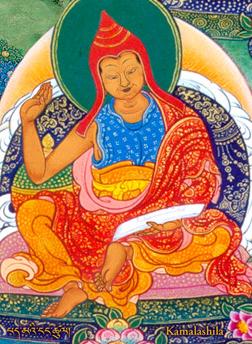Kamalashila: Difference between revisions
Jump to navigation
Jump to search
No edit summary |
No edit summary |
||
| Line 10: | Line 10: | ||
==Further Reading== | ==Further Reading== | ||
*Khenchen Thrangu Rinpoche, ''Essential Practice'', translated by Jules B. Levinson, Snow Lion | *Khenchen Thrangu Rinpoche, ''Essential Practice'', translated by Jules B. Levinson, Snow Lion | ||
*David Seyfort Ruegg, ''The Literature of the Madhyamaka School of Philosophy in India'', Wiesbaden: Harrassowitz, 1981, pp. 93-99 | |||
[[Category:Historical Masters]] | [[Category:Historical Masters]] | ||
[[Category:Seventeen Nalanda Masters]] | [[Category:Seventeen Nalanda Masters]] | ||
[[Category:Indian Masters]] | [[Category:Indian Masters]] | ||
Revision as of 08:03, 13 November 2010

Kamalashila (Skt. Kamalaśīla; Tib. Pemé Ngang Tsul; Wyl. padma'i ngang tshul) (8th century) - This master was the main disciple of the great abbot Shantarakshita. He famously defeated a Chinese master of the Hashang school (whose personal name is sometimes given as Mahayana Hashang) in the great debate at Samyé, which took place around 846 AD, thereby ensuring that the Tibetans followed the Indian tradition of Madhyamika which had flourished at the great Nalanda Monastery. His most famous compositions are the three texts entitled Stages of Meditation, on which H.H. the Dalai Lama has taught several times.
Principal Writings
- Commentary on the Difficult Points of the Compendium of Reality (Tattvasaṃgraha-pañjikā)
- Commentary on the Difficult Points of the Ornament of the Middle Way (Skt. Madhyamakālaṅkārapañjikā; Wyl. dbu ma'i rgyan gyi dka' 'grel)
- Light of the Middle Way (Skt. Madhyamakāloka; Wyl. dbu ma snang ba)
- Stages of Meditation (Skt. Bhāvanākrama)
Further Reading
- Khenchen Thrangu Rinpoche, Essential Practice, translated by Jules B. Levinson, Snow Lion
- David Seyfort Ruegg, The Literature of the Madhyamaka School of Philosophy in India, Wiesbaden: Harrassowitz, 1981, pp. 93-99